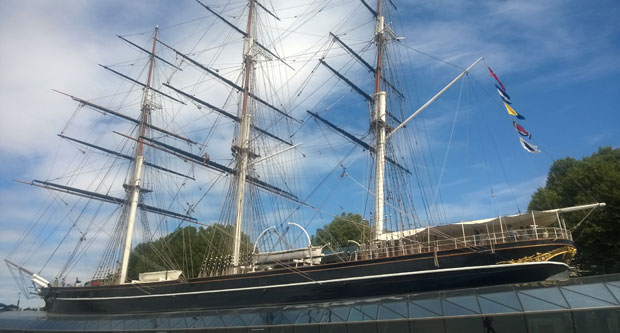One arm outstretched towards the Thames, grasping the tail of Tam o, Shanter’s horse in her hand, is the ghostly white figure of Nannie, figurehead of what was once the fastest tea clipper in the world. Below her on the brow, the words Cutty Sark glitter in bright new gilding. In old Scots, the phrase means short skirt of petticoat: the teasing garment that caused Tam, in Robert Burn’s ballad, to risk losing his life to a ghostly dancer so fleet of foot that, had she been able to cross water like her racing namesake, she would have taken him to the underworld.

Cutty Sark’s story has been the stuff of legend from the moment that Hercules Linton, of the short-lived shipyard Scott & Linton in Dumbarton, designed her for the eccentric Captain Jock ‘White Hat’ Willis, who demanded a clipper to outrun his rival the Thermopylae in the lucrative Chinese tea race. Water was still a health hazard, do daily drinks had to be boiled or alcoholic – and tea and coffee were big business.
Built in 1869 for the huge sum of £16,150 (White demanded the best materials and the inexperienced builders went bust before she launched), Cutty Sark’s slender frame was of rock elm and teak bolted on to an iron skeleton. The lower hull was protected by sheets of Muntz, or yellow, metal – an alloy of copper and zinc. At 85.4 metres (280 feet) long and weighing 963 tons, she was relatively small and slender. But with a towering main mast of 46 metres (152 feet) and 32,000 sq ft of sails, she could reach 17 knots: a veritable clip.
Clippers are sailed in one direction, rather than tacked to and fro: a major factor in speed. It was a case of point her in the right direction, and off she goes.
In 1869, when 20 million cups of tea were drunk a year, the first cargo of the annual race into harbour fetched a premium, so the tea business was cut-throat stuff. Cutty Sark revelled in it, hurtling home down the trade winds with a bellyful of aromatic leaves. Unfortunately, the Suez Canal had just been opened and the slower steamships could now get home faster than the sailing ships, which went round the Cape of Good Hope.
Cutty Sark never won the tea race but her long, working life involved 12 years in the Australian wool-trade as the fastest ship on the run, and 27 more roaming worldwide under Portuguese ownership. During her time as an active sailing vessel she was renamed twice – as the Ferreira in 1895 and the Maria do Amparo in 1916 – before her original name was reinstated. From 1922 to 1938 she had a new career as a restored, British owned training and museum ship, after which she transferred to Thames Nautical Training College. In 1957, after two years’ restoration and being set down in a purpose-built £300,000 dry dock in Greenwich, the old girl was opened to the public by the Queen.
There is a naval saying: “Harbours rot ships and men”. In the world of historic ships, concerns were raised about leaving Cutty Sark in dry dock for so long. By 2007 the Cutty Sark was in desperate need of work to repair corrosion and address deformation due to protracted sitting on her keel without hydraulic. It was during this conservation work the Cutty Sark caught fire, happily, he mast, rigging and much of the decking had been removed.
After millions of pounds in restoration work the Cutty Sark returned; sitting on 12 pairs of angled steel legs and with a two-inch-thick steel riband set in between desks, the ship gleams like a brassy giant whale or vast, leggy insect. As many hull planks as possible have been reused, freshly covered in new Muntz metal, with the addition of a steel frame to help conserve the shape.
Leaving the space below, which can cater for 500 people at large events, visitors can enter the ship – either by a glassy lift tower or a ‘disabled’ lift driven through the hull – to be immersed in high-tech museum experiences. Lights move to evoke the sea-swell and there is the wafting smell of tea, while stacked tea chests evoke a crammed hold. There is also seating for films or talks, and games for children.
Up inside the low-ceilinged ‘tween deck running the length of the magnificent vessel. It’s an exhilarating experience: the white-painted ribs to which the hull planks are fixed are only about 14 inches apart, reinforcing a strong feeling of having been swallowed by a whale. This dramatic space has many interactive displays, and can also offer silver-service dining for 100 people.
On the weather deck, three layers of watertight marine ply topped with teak planking. On here visitors can experience life on board. At the stern, the sumptuous ‘Liverpool house’ contains the Masters’ quarters, exactly recreated by shipwrights and dressed with Victorian china and cut-glass, while a ‘magic mirror’ give unsettling glimpses of a long-dead past.